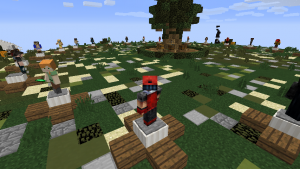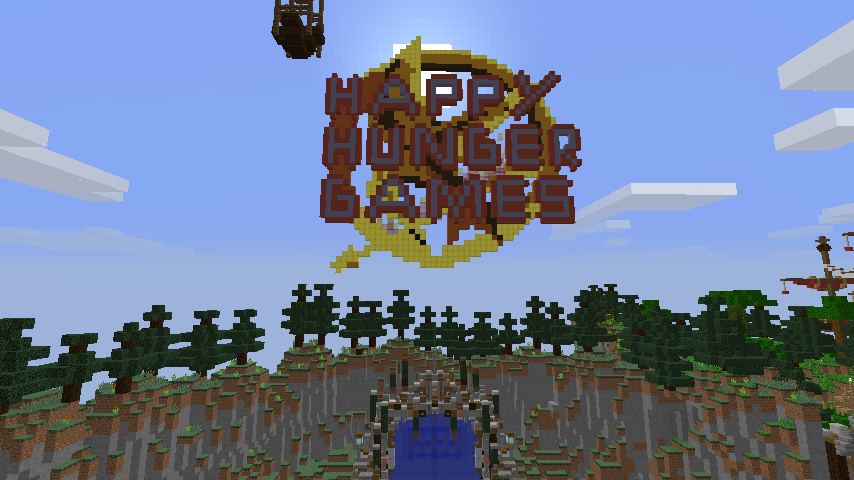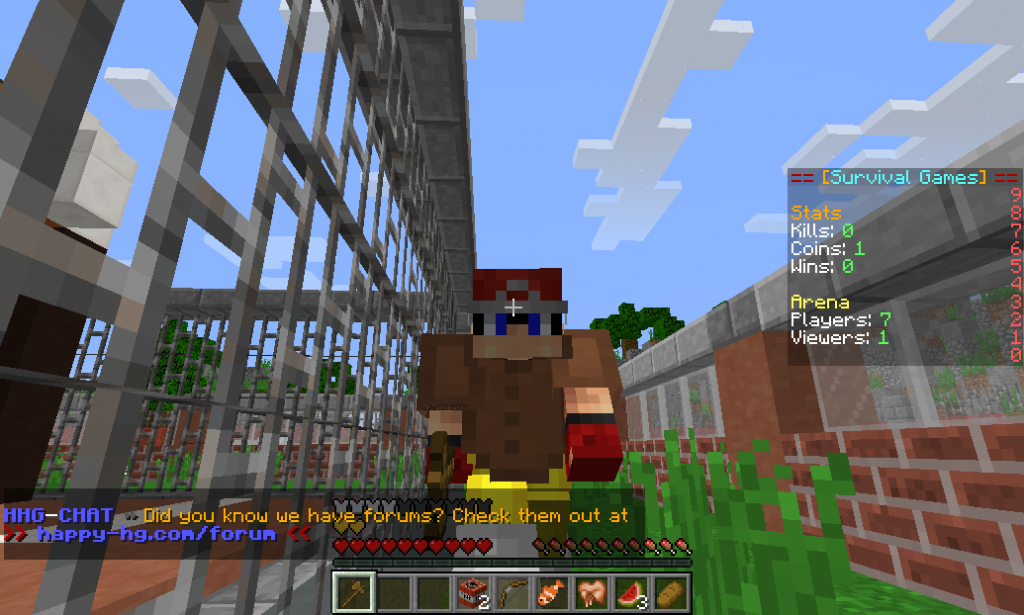Hungercraft: A Taste-Test
Over the past little while I’d made the move from being simply an observer to an active participant in the savage phenomena that is Hungercraft.
It’s been a colourful experience: I’ve done a lot of running and a lot of hiding; I’ve died within seconds while trying to remember how to open my inventory because I am Very Good at this game; I’ve mistaken ducks for other players out of the corner of my eye; I’ve killed exactly zero players, aside from one time when I lead a pursuer into an abyss, to both of our untimely demises; I’ve both gone solo and teamed up with other tributes; I’ve gotten a closer look at the behaviours of players who run around an arena – dressed in the likeness of everyone from Sephiroth to Steven Universe – trying to kill each other. It’s all been pretty fantastic.
I tried to pay particular attention to how the arena was directing my choices and actions – I wasn’t particularly interested in winning (I say purely to make myself feel better), but of absorbing and embroiling myself in the various narrative possibilities of the arena. The process itself was absolutely fascinating. I put on my ‘Researcher’ cap and set to work.
The match was a well-oiled process that took between 12 and 24 players and allowed them each a vote for the type of arena that would host the match. These ranged from cyberpunk-esque cities to tropical islands to palatial temples to thus-far unseen mysteries as a result of the democratic process at work – and the clear favoring of certain arenas over the rest. Much of the usual Hunger Games imagery was present: a depiction of Katniss’ ‘Mockingjay’ pin was an ever-present fixture in the sky above the lobby, players were referred to as ‘Tributes’, and each map had a Cornucopia in some form or another. Just as in the narratives of the film and book, the most vicious round of killing occurred at the beginning of a given match, as everyone ran for the chests in the cornucopia. By the time most of the tributes had been slaughtered, survivors were teleported into a much smaller arena for a death match, and things were usually settled within seconds.
The entire thing seemed to run more-or-less autonomously. At no point was there any human intervention, or any need for human intervention. There were consistently over a hundred players online at any given time, and it was never hard to amass a group for a round of good ol’ competitive murder. As soon as you were killed, you could head back to the lobby to start another game, ad infinitum.
In Suzanne Collins’ fictional world of Panem, each Hunger Game was a monumental affair, requiring human labor and effort to actualize. This is to say nothing of its prominence as the biggest annual cultural event for all of Panem’s citizens, making it a thing to be anticipated, dreaded, excited for, horrified of. In short, for good or for ill, a Hunger Game was a pretty Big Deal. In Minecraft, we get the fast food version of that: it’s quick, it requires minimal effort, it involves as little human intervention as possible, it offers only fleeting satisfaction, it ends just as you’re starting to enjoy it – but is always there, open for you 24 hours a day, to indulge in – and you feel just a little greasy afterwards.

Sure “Survival Arena” is great and all, but how will I ever know the majesty of “Butterland” if no one ever votes for it?
A small step towards regaining some of the pomp associated with the Hunger Games of Panem would be to, as Marie-Christine has suggested, reintroduce humans as overseers and manipulators. As such, we have geared our research towards the reintroduction of live events as a means of changing up the game – an element that falls somewhere in between player choices guided by explicit rules and player choices guided by level design. To borrow my colleague’s example, burning down a forest to flush players out of a certain area both remains true to the book and adds an element of chance (beyond whether your opponent is going to look like a deformed Homer Simpson or a deformed Pikachu) that hinges on the most chaotic variable available: the human whim!
The inclusion of human intervention calls back to a point I made earlier, regarding the strictly man vs. man conflict present in current Hungercraft games. In this case, however, if man is manipulating the natural surroundings in order to create obstacles for other players, can the conflict truly be classified as man vs. nature?
In addition to pyromania (and the like), I’d like to explore the possibility of hosting events that would lure out players of their own will – such as the feasts featured in the books, which promised food and supplies for the few tributes brave enough to enter into a common space with each other. From a research perspective, I think this will allow for a new depth of insight regarding player behavior – both for the tributes as well as for the game-makers, as well as make strides towards making Hungercraft a more social, ceremonious experience akin to Collins’ vision as described in her books. Only without raffling off the freedom of children.


